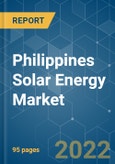The Philippine solar energy market is expected to record a CAGR of 15% during the forecast period (2022-2027). Due to the COVID-19 outbreak, the Philippine solar energy market witnessed a negative impact. The demand from the residential PV segment is severely affected due to the financial uncertainty faced by the customers. Utility-scale, commercial, and industrial solar installations slowed due to uneven cash flows and delays in commercial operations. Factors such as rapid economic development and growing population are expected to drive the market during the forecast period. However, an inefficient electricity grid infrastructure in the country is expected to hinder the market's growth in the coming years.
The Philippine solar energy market is moderately fragmented. Some of the major companies include Solar Philippines Power Project Holdings, Solenergy Systems Inc., Vena Energy, Solaric Corp., and Trina Solar Ltd.
This product will be delivered within 2 business days.
Key Highlights
- With the increased solar PV installations across the country, the solar PV segment is expected to register significant growth due to increasing small-scale solar PV deployment during the forecast period.
- It is estimated that replacing/integrating diesel generators with renewable energy, like solar, can save the country over USD 200 million per year. Small islands in the Philippines are powered by generator-based mini-grids fueled by imported diesel and bunker (freighter) oil. These islands suffer from blackouts and unplanned power outages due to grid instability, inadequate generation capacity, and lack of subsidized fuel. Therefore, off-grid electrification through renewable energy sources, such as solar, is expected to create a significant opportunity in the future.
- The growing demand for solar energy-based power generation and declining photovoltaic system prices are expected to drive the market during the forecast period.
Key Market Trends
Solar Photovoltaic (PV) to Register Significant Growth
- Solar energy provides an immediate solution to the country’s growing energy needs. With steadily falling costs of solar power equipment and the short amount of time needed to install and commission solar power projects, solar photovoltaic systems are increasingly becoming popular among consumers and industries across the Philippines.
- In 2020, the Department of Energy (DOE) released the Philippine Energy Plan 2020-2040, establishing the country’s goal for renewable energy to reach 35% of its power generation mix by 2030 and 50% by 2040. This development, in turn, will culminate in the increasing deployment of solar PV across the country.
- As of 2020, the country witnessed 1,048 MW of solar PV installations. It is observing growing demand for solar PV from industrial and commercial segments, which may positively impact the growth of the solar energy market in the Philippines.
- Small-scale solar photovoltaic (PV) has been widely adopted by the residential sector in the Philippines, mainly due to the declining cost of PV technology and the introduction of net metering.
- However, despite the net metering policy, the residential and commercial sector has witnessed limited growth for PV installation of up to 100 kW in size since 2013. The slow growth has been mainly due to administrative, financial, and regulatory hurdles, preventing small owners and medium-sized enterprises from installing rooftop solar.
- Hence, due to the increasing solar photovoltaic installations across the country, the solar PV segment will likely dominate the Philippine solar energy market during the forecast period.
Declining Costs of Solar PV to Drive the Market
- The solar industry has cut costs dramatically through economies of scale in the past six years. As the market was flooded with equipment, prices plummeted. In 2011, the price of solar panels declined by 48.4%, while the PV system costs dropped by more than 30% since 2008. As of 2021, solar photovoltaic (PV) modules are more than 80% cheaper than in 2011, culminating in an increase in solar installations across the country and favoring the market’s growth.
- The cost of electricity from solar PV declined by almost three-fourths during 2010-2020, and it continues to decline. The cost reductions are driven by continuous technological improvements, including higher solar PV module efficiencies. The industrialization of these highly modular technologies yielded impressive benefits from economies of scale and greater competition to improved manufacturing processes and competitive supply chains.
- As of 2021, global module prices have dipped as low as USD 0.24/W. As the prices of solar panels are declining, consumers are showing interest in installing solar panels to incur tax benefits and low electricity bills, which may remarkably impact the growth of the solar energy market in the Philippines.
- Thus, the declining photovoltaic system prices are expected to increase the adoption of solar power in the Philippines and drive the market during the forecast period.
Competitive Landscape
The Philippine solar energy market is moderately fragmented. Some of the major companies include Solar Philippines Power Project Holdings, Solenergy Systems Inc., Vena Energy, Solaric Corp., and Trina Solar Ltd.
Additional Benefits:
- The market estimate (ME) sheet in Excel format
- 3 months of analyst support
This product will be delivered within 2 business days.
Table of Contents
1 INTRODUCTION
4 MARKET OVERVIEW
5 MARKET SEGMENTATION - BY TECHNOLOGY
6 COMPETITIVE LANDSCAPE
Companies Mentioned (Partial List)
A selection of companies mentioned in this report includes, but is not limited to:
- Solar Philippines Power Project Holdings
- Solenergy Systems Inc.
- Vena Energy
- Solaric Corp.
- Trina Solar Ltd
- AC Energy
- Cleantech Global
- Citicore Power Inc.
- Aboitiz Power Corporation
- Helios Solar Energy Corporation (HSEC)
Methodology

LOADING...








